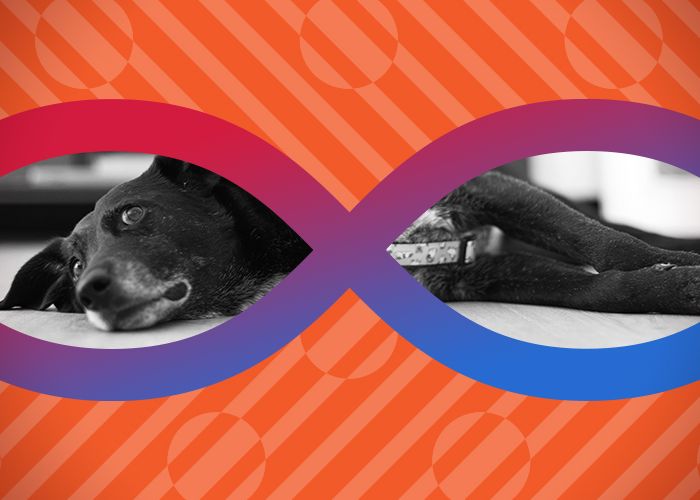

How To Distinguish B-Cell Lymphoma From T-Cell Lymphoma in Dogs
The adage, "B is better, T is terrible" is based on the idea that B-cell lymphoma tends to be more responsive to treatment than T-cell, and dogs with T-cell lymphoma are more likely to be hypercalcemic and have signs of illness at diagnosis or relapse. Differentiating B-cell from T-cell, as well as identifying more aggressive B-cell and indolent T-cell variants among dozens of subtypes, is ideal for optimal patient care and client communication.1 Here's what you need to know about the role of lymphocytes in immune function, determining immunophenotypes, and immunophenotype impact on treatment.
The Role of B and T Cells in Immune Responses
Immune function is divided into innate and adaptive immunity. Innate immune responses are the first-line defenses against pathogens, including anatomic and physiologic barriers, phagocytes and natural killer cells, and inflammation. The innate immune system responds to molecular patterns that are common across pathogens or caused by tissue damage.2
On the other hand, adaptive immune responses are aimed at antigens that are specific to a particular pathogen and are generated by lymphocytes. Lymphocytes develop in primary lymphoid organs—including bone marrow, the thymus, and the fetal liver—and become activated in secondary lymphoid organs, such as the spleen, tonsils, lymph nodes, and mucosa-associated lymphoid tissues.
The adaptive immune system can "remember" antigens that have previously been detected and be triggered to quickly respond if that antigen is encountered again through the release of antibodies (immunoglobulins) from B cells. Some T cells work with B cells to stimulate this immune response (CD4+ helper T cells), while some directly kill cells infected with pathogens (CD8+ cytotoxic T cells). The adaptive immune system can also differentiate "self" (the animal's own cells) from "non-self" (pathogens and sometimes cancer).
The primary role of T cells is to interact with major histocompatibility complex (MHC) molecules that bring antigens from inside the cell to the surface. If foreign antigens or abnormal tumor antigens are detected, the T cells can trigger the destruction of the cell. T cells can be activated to serve many other roles including recruiting other types of white blood cells, stimulating inflammatory responses, and even suppressing inflammation and immune responses.2
Methods for Immunophenotyping in Canine Lymphoma
The type of lymphocyte can be identified by detecting different antigens. B cells typically express the antigens CD79a, CD20, CD21, and PAX5, while T cells typically express CD3, CD5, and CD4 or CD8.1,3 A biopsy for histopathology along with immunohistochemistry (IHC) is considered the gold standard for diagnosing lymphoma, but other methods are less invasive and may be more cost-effective.1 Different methods can be used to detect these antigens using different samples, including:
- Immunocytochemistry (ICC); performed on cytology slides)
- Immunohistochemistry (IHC); performed on histology sections)
- Flow cytometry (performed on live cells collected from fine needle aspirates, blood, bone marrow, or effusions)
- A blood test that detects circulating canine lymphoma-specific biomarker
PCR for Antigen Receptor Rearrangements (PARR) doesn't detect antigens, but rather T-cell receptor (TCR) or immunoglobulin (B-cell) genes. When only a single TCR gene or immunoglobulin gene is detected, it's called a clonal population, and it's likely cancer is present. If multiple TCR genes or immunoglobulin genes are detected, it's called a polyclonal population—meaning it's less likely cancer and more likely a normal immune response.1

Treating Dogs With Lymphoma
CHOP-based chemotherapy—or chemotherapy typically using a combination of four types of drugs (Cyclophosphamide, Hydroxydaunorubicin [doxorubicin], Oncovin [vincristine], and Prednisone)—is considered the standard of care for aggressive canine lymphomas.1 Dogs with B-cell lymphoma tend to respond better and longer to treatment with CHOP compared to dogs with T-cell lymphoma. In one study, dogs with B-cell lymphoma treated with CHOP had a median response duration of 252 days—meaning that half of the dogs lived that long or longer4 —compared to 146 days5 for dogs with T-cell lymphoma in another study.
Immunophenotyping with IHC or flow cytometry can identify indolent or less aggressive forms of T-cell lymphoma like T-zone lymphoma, or more aggressive forms of B-cell lymphoma. T-zone lymphoma is an unusual lymphoma seen more often in golden retrievers that may affect a few lymph nodes, all of the lymph nodes, or the blood. T-zone lymphomas express a variety of T-cell antigens (CD3+, CD4+, CD25+), but most don't express CD45.6,7 The median survival time for dogs with T-zone lymphoma in one study was 637 days6 vs. 159 days for dogs with the more typical, aggressive T-cell lymphomas in another study.8 T-zone lymphoma usually isn't treated with CHOP, so identifying this form of lymphoma often changes the initial treatment recommendation.
While most B-cell lymphomas have a better prognosis and response to treatment than T-cell lymphomas, some are associated with worse outcomes. Flow cytometry can detect the expression of MHC class II, which is important in the recognition of cells by the immune system. B-cell lymphomas with low MHCII expression have worse outcomes for dogs (median survival of 120 days or longer for low vs. 314 days for high MHCII expression), and this is also seen in people with B-cell lymphoma.9 This is because cancer cells with low MHCII expression may be able to evade detection and destruction by the immune system.9
Optimizing Success Rates
"B is better, and T is terrible" is an oversimplification of the complex nature of canine lymphoma—yet it can still be a helpful reminder as a guide during diagnosis. Throughout diagnosis, many tools for characterizing and immunophenotyping are available, including cytology, histology, IHC, ICC, PARR, and flow cytometry. Immunophenotyping can help guide conversations with owners about treatment options and prognosis for dogs with lymphoma. Knowing the immunophenotype of a dog's lymphoma allows veterinarians to more accurately prognosticate and guide owner expectations for treatment and outcomes.1
References
1. Vail DM, Pinkerton M, Young KM. "Hematopoietic Neoplasia." Withrow and MacEwen's Small Animal Clinical Oncology 6th Edition. Edited by Vail DM, Thamm DH, Liptak JM. Elsevier, 2019, pp 688-772
2. Snyder, PW. "Diseases of Immunity." Pathologic Basis of Veterinary Disease 7th Edition. Edited by Zachary, JF. Mosby, 2021, pp 295-340
3. Rout ED, Avery PR. Lymphoid neoplasia: correlations between morphology and flow cytometry. Vet Clin North Am Small Anim Pract 2017; 47(1):53-70 doi: 10.1016/j.cvsm.2016.07.004
4. Childress MO, Ramos-Vara JA, Ruple A. Retrospective analysis of factors affecting clinical outcome following CHOP-based chemotherapy in dogs with primary nodal diffuse large B-cell lymphoma. Vet Comp Oncol 2018; 16(1):E159-E168. doi: 10.1111/vco.12364
5. Rebhun RB et al. CHOP chemotherapy for the treatment of canine multicentric T-cell lymphoma. Vet Comp Oncol 2011; 9(1):38-44 doi: 10.1111/j.1476-5829.2010.00230.x
6. Seeling DM, et al. Canine T-zone lymphoma: unique immunophenotypic features, outcome, and population characteristics. J Vet Intern Med 2014; 28(3);878-886. doi: 10.1111/jvim.12343
7. Stein L, Bacmesiter C, Kiupel, M. Immunophenotypic characterization of canine nodal T-zone lymphoma. Vet Pathol 2020; 58(2):288-292. doi: 10.1177/0300985820974078
8. Avery PR et al. Flow cytometric characterization and clinical outcome of CD4+ T-cell lymphoma in dogs: 67 cases. J Vet Intern Med 2014; 28(2):538-546. doi: 10.1111/jvim.12304
9. Rao S et al. Class II major histocompatibility complex expression and cell size independently predict survival in canine B-cell lymphoma. J Vet Intern Med 2011; 25(5):1097-105. doi: 10.1111/j.1939-1676.2011.0767.x







